
Choosing a Berberis
OUR BUYING GUIDE TO MAKE THE RIGHT CHOICE
Contents
Berberis are thorny bushes, highly valued for their decorative and colourful foliage. Depending on the variety, their small deciduous or evergreen leaves come in shades of purple, pink, orange, or green, complemented by yellow-orange flowering. Also known as barberry, it is easy to grow in any well-drained soil and enjoys full sun or partial shade. Hardy, Berberis requires no maintenance but tolerates pruning very well. This bush is perfect for creating a defensive hedge, whether free-form or trimmed. The beautiful coloured foliage will also enhance a slope, a rockery, a bed of shrubs or perennials, and even a pot on the terrace. Follow our guide to help you choose your Berberis based on your garden and its use.
→ You will find everything you need to know about Berberis in our comprehensive file Berberis, barberry: plant, prune, and maintain.
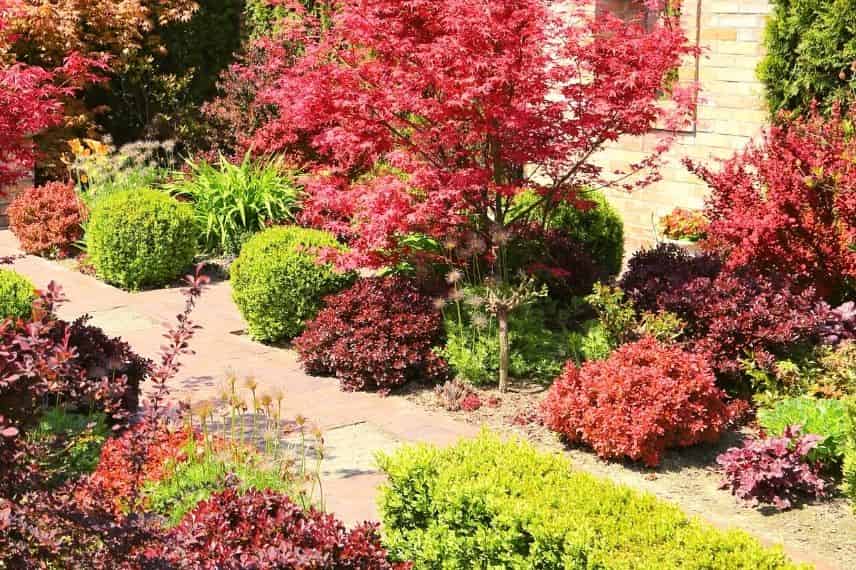 The bushy and dense form of Berberis, along with their purple, orange, or golden green colours, adds vibrancy to the garden, alongside boxwood, Heucheras, and Japanese maple.
The bushy and dense form of Berberis, along with their purple, orange, or golden green colours, adds vibrancy to the garden, alongside boxwood, Heucheras, and Japanese maple.
According to leaf persistence
The persistence of foliage is one of the first criteria that can help you make your choice. Indeed, Berberis can be primarily classified into two categories:
Deciduous Berberis
Deciduous varieties have leaves that are often ovate in shape with smooth edges. These bushes stand out for the richness of their foliage colours, ranging from pink to purple, including orange and red. The arrival of cold intensifies the scarlet colour, offering us a lovely ephemeral autumn display. Lemon-yellow to orange flowers bloom discreetly in May-June. Very hardy down to -40 °C, they can be planted in all regions, even the coldest. They prefer a sunny exposure but will tolerate partial shade better in southern regions. These Berberis will be perfect for creating trimmed defensive hedges.
Evergreen Berberis
Evergreen cultivars offer a less varied colour palette that mainly ranges from medium green to dark green. Depending on the variety, their small leaves are often glossy, some are rounded with smooth edges while others are dentate and thorny like those of holly. These Berberis will be ideal for creating a hedge that is both privacy-protecting and defensive. Flowering is also more abundant, and their yellow-orange flowers are more fragrant. Some varieties are even appreciated for their earliness, such as Berberis Darwini, which blooms in March-April. It is worth noting that evergreen Berberis are less cold-resistant than deciduous varieties. Indeed, they generally withstand frosts down to -15 °C, or even -20 °C for Berberis julianae. However, they tolerate salt spray better and prefer partial shade over full sun.
→ Learn more in Ingrid’s advice sheet: Evergreen Berberis, the most beautiful varieties
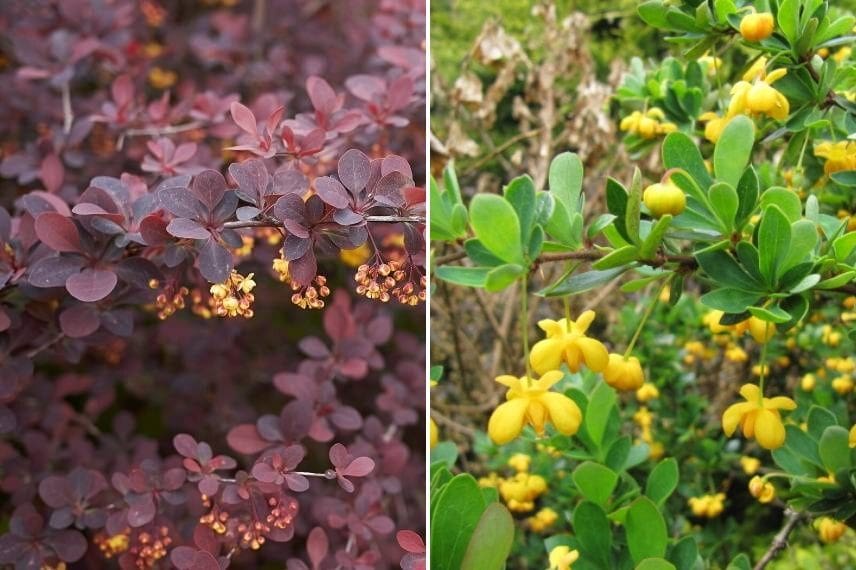 On the left: Berberis thunbergii ‘Atropurpurea’ with deciduous purple foliage. On the right: Berberis buxifolia ‘Nana’ with evergreen green foliage.
On the left: Berberis thunbergii ‘Atropurpurea’ with deciduous purple foliage. On the right: Berberis buxifolia ‘Nana’ with evergreen green foliage.
Read also
When and how to prune barberry?According to the colour of the foliage
With Berberis, the first thing that catches the eye is their foliage! Bright green, golden, pink, purple, or variegated? There’s something for every taste and every garden. If there’s one criterion to guide your choice, it’s this one.
Golden Foliage
Berberis with golden foliage attract attention with their beautiful leaves in vibrant lime green tones. Among the brightest, the following examples stand out:
- The Berberis thunbergii ‘Tiny Gold’ features a lovely rounded habit and very bright deciduous foliage, light green with golden reflections.
- The Berberis thunbergii ‘Golden Carpet’ forms a low, spreading bush with beautiful golden yellow to chartreuse green foliage that takes on a lovely orange hue in autumn.
- The Berberis thunbergii ‘Golden Dream’ is a remarkable shrub for its luminous foliage, as well as its low, spreading habit with gracefully arching branches.
- The Berberis thunbergii ‘Golden Rocket’ stands out with its upright habit that brings light thanks to its small, bright yellow-green foliage that withstands full sun well.
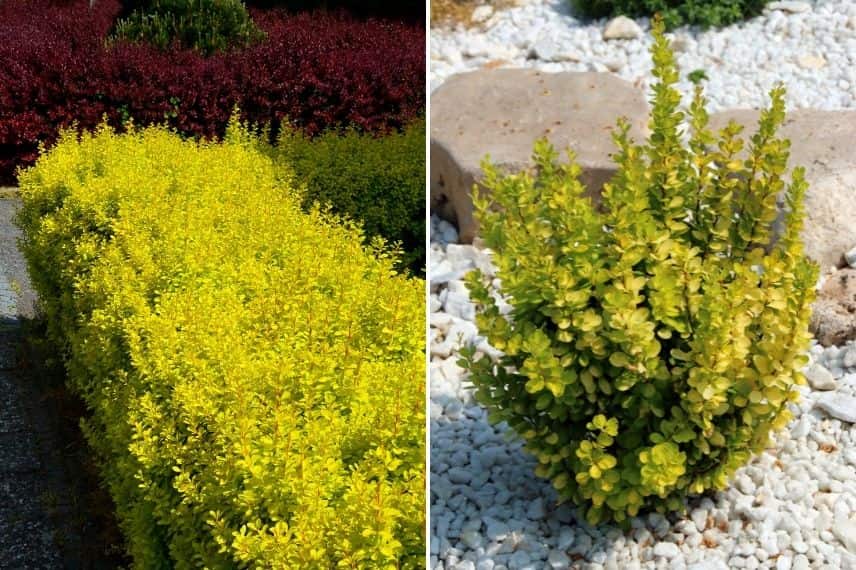
The Berberis thunbergii ‘Golden Rocket’ has golden green foliage that adds brightness both in a hedge and in a rockery.
Green Foliage
Green, whether shiny or matte, remains a safe bet in the garden. Here are a few examples:
- The Berberis darwinii ‘Nana’ has a holly-like appearance with its spiny, dentate leaves of deep, shiny green.
- The Berberis buxifolia ‘Nana’ is a dwarf variety, forming a dense cushion of small, evergreen leaves similar to those of boxwood.
- The Berberis julianae has a tall, dense habit, reaching up to 3 m in height. It bears small, shiny dark green spiny leaves that turn red in cold weather.
- The Berberis linearifolia ‘Orange King’ features dark green, glossy foliage on its arching branches. It is distinguished by its abundant spring flowering of bright orange.
- Also, check out our selection in our article: 6 Green-Leaved Berberis for All Seasons.

The Berberis julianae has dark green, spiny, dentate foliage, resembling small holly leaves.
Pink to Purple Foliage
From cream pink to almost black purple, passing through red and orange, Berberis offers an immense palette of colours. These colourful bushes are perfect for creating a lovely contrast with lighter shrubs, whether in a hedge or a shrub bed. Here are some of the most remarkable:
- The Berberis ottawensis ‘Superba’ is a large, vigorous shrub with arching branches bearing purple-violet foliage that turns crimson red in autumn.
- The Berberis thunbergii ‘atropurpurea’ forms a beautiful bushy shrub with lovely purple foliage and abundant yellow flowers striped with red.
- The Berberis thunbergii ‘Orange Ice’ is a small compact variety, whose upright stems are covered with bright red-orange foliage.
- The Berberis thunbergii ‘Lutin Rouge’ forms a small compact ball, with scarlet red foliage that gradually turns purple when exposed to sunlight.
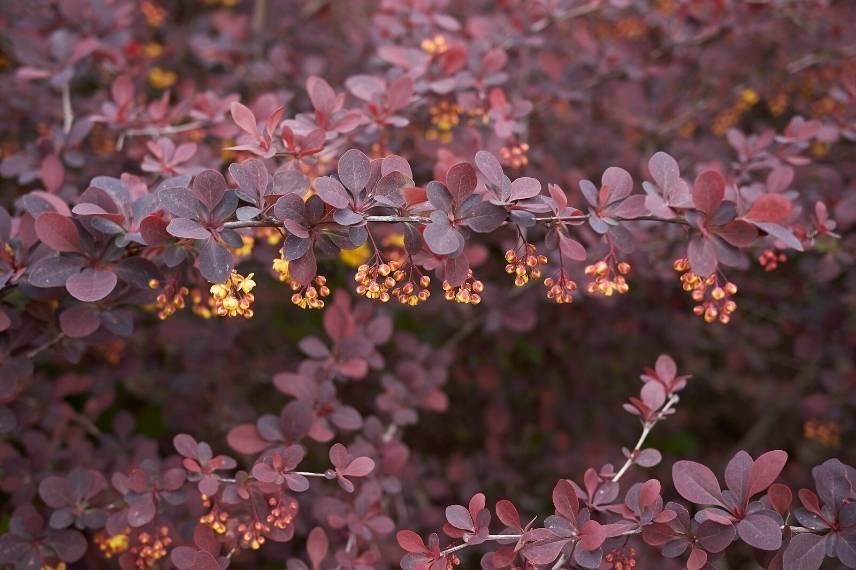
The Berberis thunbergii ‘atropurpurea’ and its purple foliage.
Variegated Foliage
Surprising and original, variegated Berberis will not go unnoticed in the garden. Here’s a small selection:
- The Berberis thunbergii ‘Natasza’ is distinguished by its vividly coloured foliage. Its small leaves emerge splashed with bright pink and cream, then evolve to green and white, ultimately turning orange-yellow in autumn.
- The Berberis thunbergii ‘Limoncello’ is a lovely little original bush thanks to the colour of its chartreuse green foliage with a red edge, taking on warm hues in autumn.
- The Berberis thunbergii ‘Rosy Rocket’ has beautiful red foliage speckled with pink and white before turning purple in autumn.
- The Berberis thunbergii ‘Harlequin’ offers young leaves that are purple splashed with pink and silver-white in spring. They turn purple in summer, then red in autumn.
- The Berberis thunbergii ‘Inspiration’ forms a small compact cushion. Its young purple foliage is marbled with pink and white, then turns purple at maturity before taking on orange-red tones in autumn.
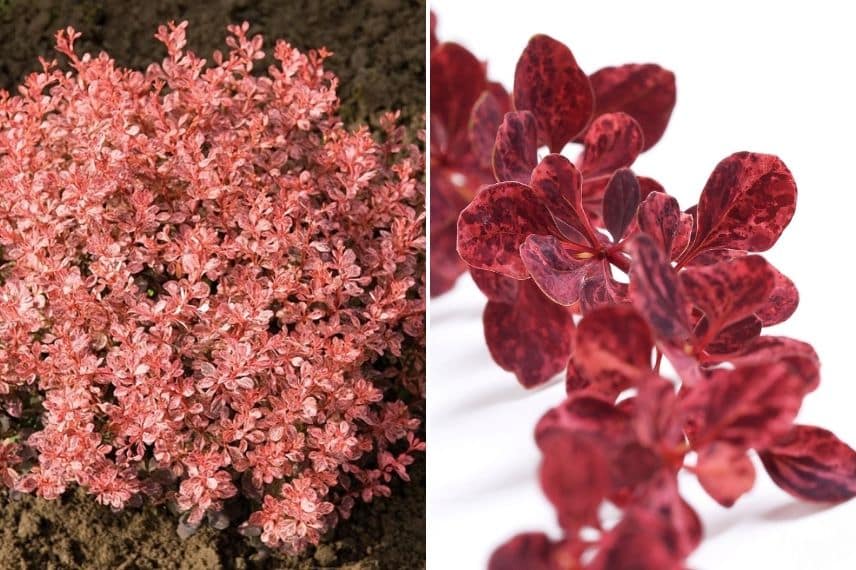
The young foliage of the Berberis thunbergii ‘Inspiration’ is marbled with pink and white, before becoming entirely purple at maturity.
Discover other Berberis - Barberries
View all →Available in 2 sizes
Available in 1 sizes
Available in 2 sizes
Available in 1 sizes
Available in 1 sizes
Available in 1 sizes
Available in 3 sizes
Available in 1 sizes
Available in 1 sizes
Available in 3 sizes
Depending on the use
Did you know that there are no fewer than 400 species of barberry? Aside from the colour and persistence of the foliage, there is also another important criterion: the use of Berberis. Whether in hedges, rockeries, or borders, you should consider this in your choice to select a barberry with the appropriate size and shape.
In a hedge
Barberries are perfect for creating a defensive hedge, whether free-form or strictly trimmed. Their naturally bushy and dense habit requires no cutting or maintenance, but they respond well to pruning. Note that flowering will be less abundant the following year, or even absent in the case of severe pruning.
For a low hedge, choose small varieties that will require less frequent trimming, such as Berberis Darwinii ‘Nana’ or the cultivar ‘Orange Dream’.
To form a medium hedge, install intermediate-sized shrubs, such as Berberis thunbergii, Berberis thunbergii ‘atropurpurea’, or Berberis thunbergii ‘Golden Rocket’ with its lovely golden-green foliage, reaching 1.5 m at maturity.
To create a tall hedge, you can plant large varieties such as Berberis julianae or Berberis darwinii, which can reach 3 m in height. This will create an impenetrable hedge! For a touch of purple, opt for Berberis ottawensis ‘Superba’.

A free-form hedge of Berberis thunbergii ‘atropurpurea’
In a shrub border
Barberries will bring a remarkable splash of colour to a shrub border with their green, golden, purple, or pink foliage. Their naturally bushy and rounded shape will blend beautifully into this setting, requiring no maintenance. The size of the barberry will depend on its placement. For example, at the back of the border, plant large specimens, such as Berberis thunbergii ‘Red Rocket’. At the front of the border, install small cultivars, such as Berberis Thunbergii ‘Bagatelle’. Prefer varieties with a dense and rounded shape.
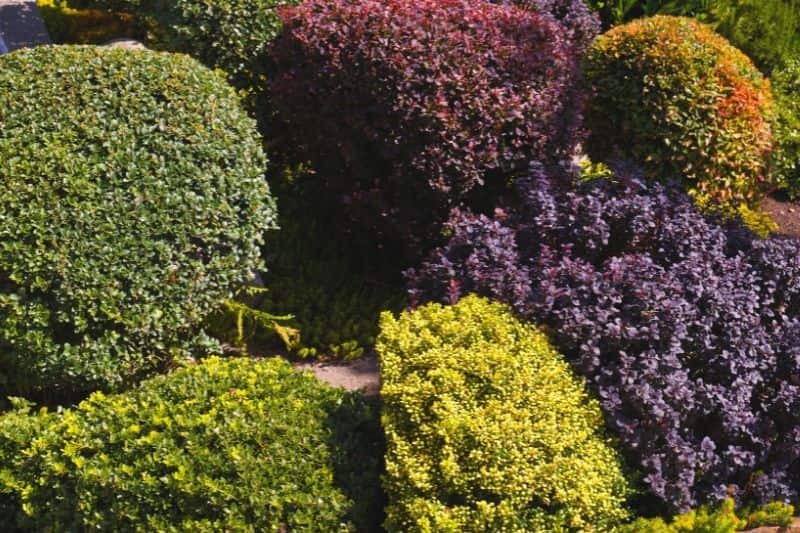
Rounded barberries in a shrub border
In a rockery
Barberry is a low-maintenance shrub that is easy to grow. This hardiness makes it an excellent choice for a rockery in full sun or partial shade. Moreover, its dense and compact habit requires no maintenance. Choose rounded varieties that will form lovely little cushions, such as the surprising ‘Tiny Gold’ with its small golden-green leaves or thunbergii ‘Inspiration’ with its purple and pink marbled colour. Once well established, they tolerate summer drought without issues, except in Mediterranean coastal regions.

Barberry also thrives in a rockery in full sun
In pots on the terrace or balcony
For use on the terrace, prefer small rounded varieties that will thrive in pots. Also, choose less spiny barberries to avoid any inconvenience when passing by. Therefore, we recommend the cultivar buxifolia ‘Nana’, which is among the least prickly cultivars. You might also consider the charming thunbergii ‘Lutin Rouge’, which is very appealing for its round shape and beautiful purple colour, or thunbergii ‘Atropurpurea Nana’. To add brightness to the balcony, you can be tempted by the luminous foliage of the small ‘Tiny Gold’.
→ Find our tips for successfully growing barberry in pots and Barberry: 5 easy and colourful varieties to grow in pots.
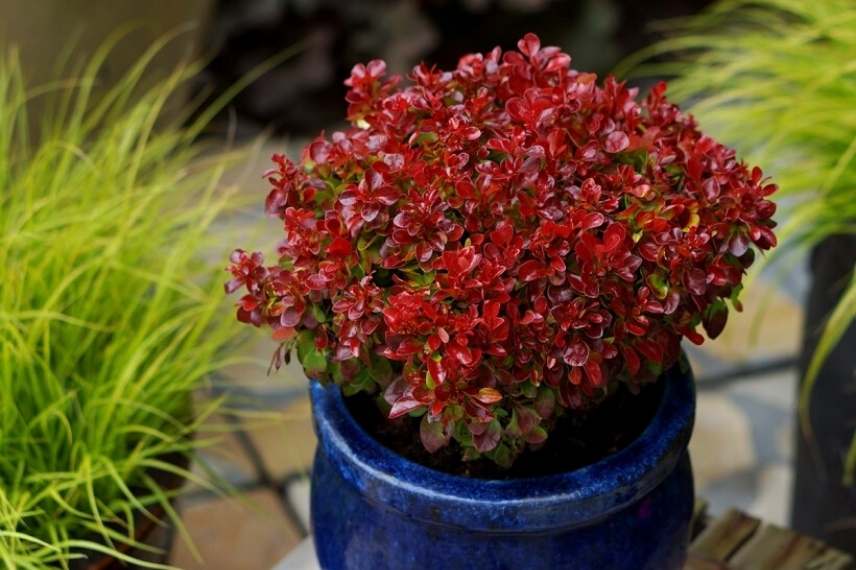
The small size of Berberis thunbergii ‘Lutin Rouge’ is perfect for pot cultivation
As groundcover
To enhance a slope or cover soil, choose barberries with a spreading and dense habit, wider than tall. This is the case for the cultivar ‘Green Carpet’ or ‘thunbergii Golden Carpet’, which have a low and wide form, as well as lovely bright green foliage. Rounded but low varieties will also be suitable, such as Berberis ‘Bagatelle’ with its lovely cushion-like purple shape. This will provide a change from traditional Cotoneasters, St. John’s Wort, and other Lonicera.
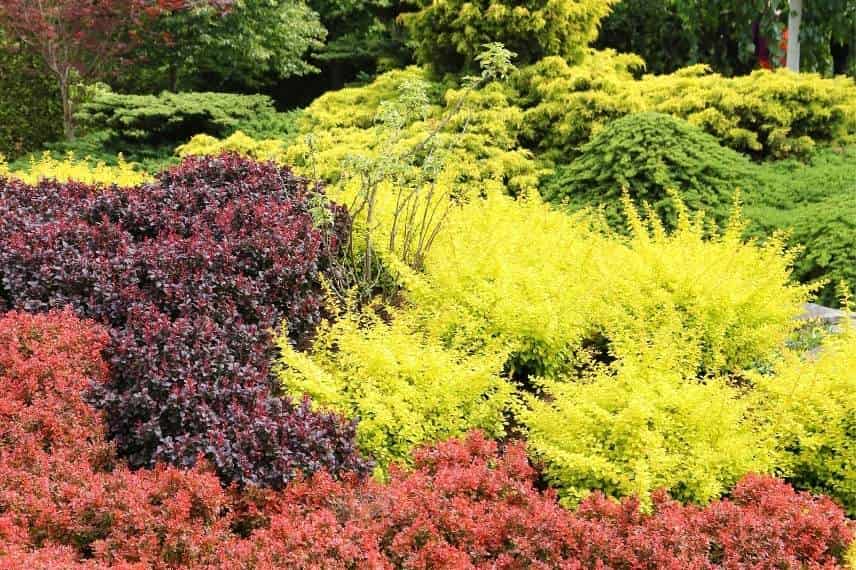
Whether orange, purple, or yellow-green, barberry forms a beautiful dense groundcover
Read also
How to pair Berberis?For further reading
- Discover all our varieties of Barberry
- Find our article to learn all about barberries: planting, pruning, and maintaining
- Olivier presents some lovely varieties in this video:
- Subscribe!
- Contents
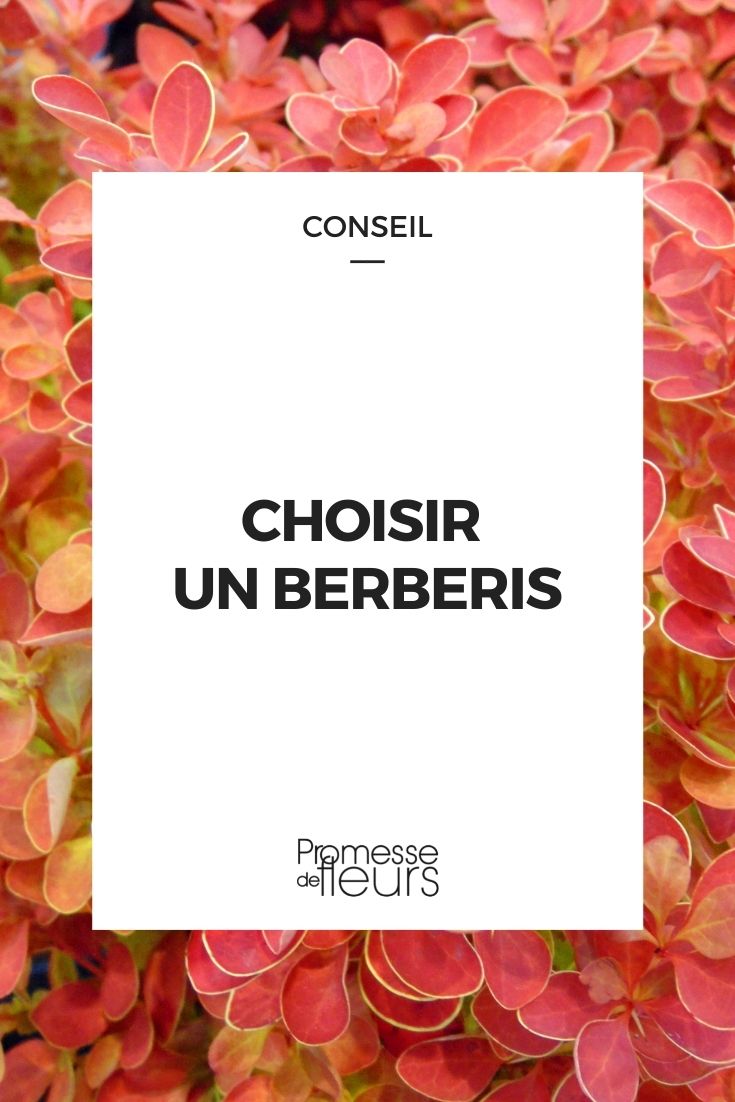































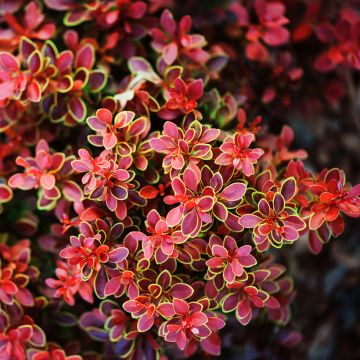

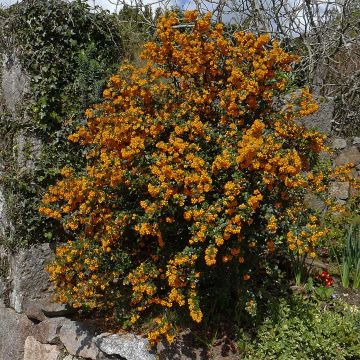

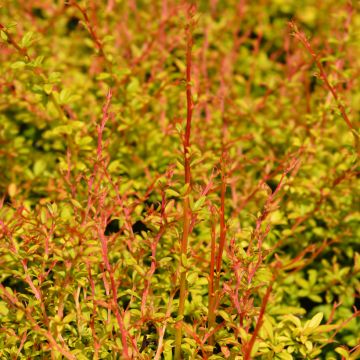
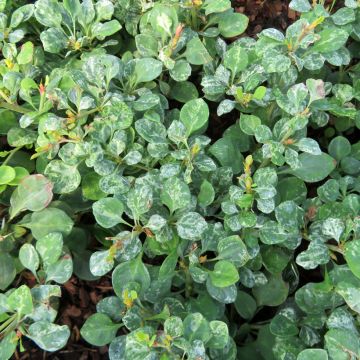
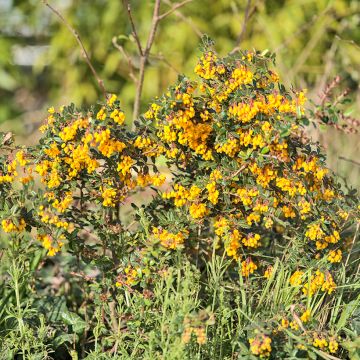

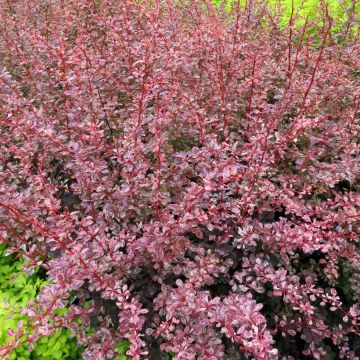
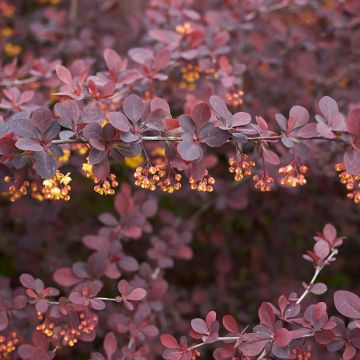
Comments